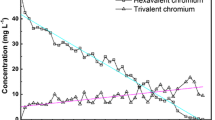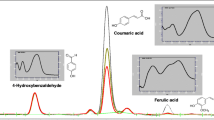Abstract
The crude extracellular cellulase from Clostridium thermocellum was oxidatively inactivated by air and inhibited by sulfhydryl reagents. Activity-loss was prevented and reversed by the addition of a high concentration (10 mM) dithiothreitol (DDT) at zero time and up to 24 h respectively. In the presence of a low concentration (0.4 mM) of DTT, the enzyme was more rapidly inactivated than in air alone. This was probably due to autoxidation of the low DTT concentration to H2O2 as shown by its prevention by a high DTT concentration, exclusion of air, or catalase; and by the oxidative inactivation of the enzyme by H2O2. The inactivation by H2O2 could be prevented by a high concentration of DTT but not by air exclusion. EDTA protected the enzyme from inactivation in air by a low concentration of DTT or by H2O2. This is presumably due to the role of metals in oxidation of SH groups. Furthermore, copper (5 μM) also caused inactivation and this was prevented by the presence of a high DTT concentration. Even in the protective atmosphere of a high DTT concentration, cellulase was inactivated by certain apolar chelating agents such as o-phenanthroline and α-α1-dipyridyl, such inactivation being preventable by the prior incubation of the chelator with a mixture of Fe2+ and Fe3+. These data suggest that the clostridial cellulase, unlike the enzyme from aerobic fungi, contains essential sulfhydryl groups and is stimulated by iron. The endo-β-glucanase component of the cellulase complex was not susceptible to oxidative inactivation.
Similar content being viewed by others
Abbreviations
- DTT:
-
dithiothreitol
- CMC:
-
carboxymethylcellulose
- DTNB:
-
5,5′-dithiobis-(2-nitrobenzoic acid)
- NEM:
-
N-ethylmaleimide
- p-CMB:
-
p-chloromercuribenzoic acid
References
Bradford MM (1976) A rapid and sensitive method for the quantitation of microgram quantities of protein utilizing the principle of protein-dye-binding. Anal Biochem 72:248–254
Bragg PD (1974) Nonheme iron in respiratory chains. In: Neilands JB (ed) Microbial iron metabolism. Academic Press, New York, pp 303–348
Costa M, Pecci L, Pensa B, Cannela C (1977) Hydrogen peroxide involvement in the rhodanese inactivation by dithiothreitol. Biochem Biophys Res Commun 78:596–603
Eriksson KE, Petterson B, Westermark U (1974) Oxidation: An important enzyme reaction in fungal degradation of cellulose. FEBS Lett 49:282–285
Fahey RC, Hunt JS, Windham GC (1977) On the cysteine and cystine content of proteins. Differences between intracellular and extracellular proteins. J Mol Evol 10:155–160
Halliwell B (1982) Superoxide and superoxide-dependent formation of hydroxyl radicals are important in oxygen toxicity. TIBS 7:270–272
Jocelyn PC (1972) Biochemistry of the SH-group. Academic Press, London
Johnson EA, Sakajoh M, Halliwell G, Madia A, Demain AL (1982) Saccharification of complex cellulosis substrates by the cellulase system from Clostridium thermocellum. Appl Environ Microbiol 43:1125–1132
McBee RH (1950) The anaerobic thermophilic cellulolytic bacteria. Bacteriol Rev 14:151–163
Misra HP (1974) Generation of superoxide free radical during the autoxidation of thiols. J Biol Chem 149:2151–2155
Ng TK, Zeikus JG (1981) Purification and characterization of an endoglucanase (1,4-β-d-glucan glucanohydrolase) from Clostridium thermocellum. Biochem J 199:341–350
Petre J, Longin R, Millet J (1981) Purification and properties of an endo-β-1,4-glucanase from Clostridium thermocellum. Biochimie 633:629–639
Smith WR, Yu I, Hungate RE (1973) Factors affecting cellulolysis by Ruminococcus albus. J Bacteriol 114:729–737
Thornton JM (1981) Disulfide bridges in globular proteins. J Mol Biol 151:261–287
Torchinsky YM (1981) Sulfur in proteins. Pergamon Press, England. Witterberg W (translator). Metzler D (translation ed)
Trotta PP, Pinkus LM, Meister A (1974) Inhibition by dithiothreitol of the utilization of glutamine by carbamylphosphate synthetase. Evidence for formation of hydrogen peroxide. J Biol Chem 249:1921–1951
Waksman SA, Skinner CE (1926) Microorganisms concerned in the decomposition of cellulose in the soil. J Bacteriol 12:57–84
Williams RJP (1981) Natural selection of the chemical elements. Proc R Soc Lond B 213:361–397
Author information
Authors and Affiliations
Rights and permissions
About this article
Cite this article
Johnson, E.A., Demain, A.L. Probable involvement of sulfhydryl groups and a metal as essential components of the cellulase of Clostridium thermocellum . Arch Microbiol 137, 135–138 (1984). https://doi.org/10.1007/BF00414454
Received:
Accepted:
Issue Date:
DOI: https://doi.org/10.1007/BF00414454




